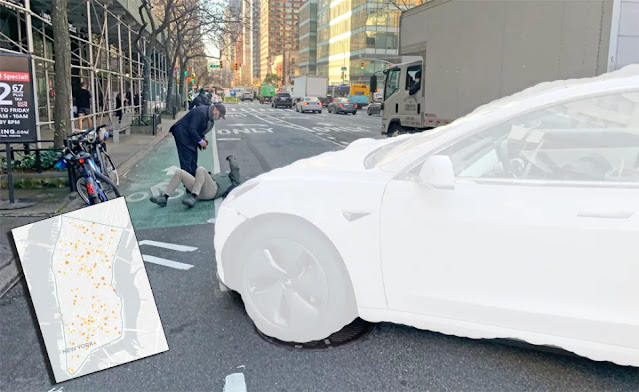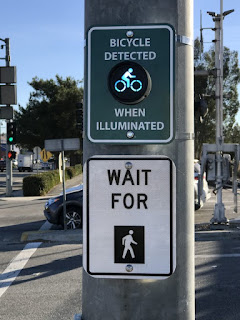A few years ago, I taught a "capstone" course, required of graduating students, about the Bronx. It seemed to make sense, as the college is located in the borough--in the heart of the poorest U.S. Congressional District, in the South Bronx--and most students live there. As much as I tried to make it interesting and relevant, students were less than unenthusiastic: They saw the course as one more thing standing between them and graduation.
If they've forgotten me, the projects they did (or didn't do), the class itself and the college, I hope they remember one lesson that, I believe, the course reinforced: Everything they lived with, good and bad, in the Bronx was the result of decisions made by human beings. Sometimes their motives were nefarious, but at other times they were simply misguided.
Fahrad Manjoo makes that point today in a New York Times editorial, "Bike Riding In America Should Not Be This Dangerous." In his essay, he briefly recounts how urban and transportation has prioritized the "speedy movement of vehicles over the safety of everyone else on our streets. He doesn't get much into specifics--whole books have been written about that--but that governing principle took hold well before the high priest of auto-centricity, Robert Moses, started his work.
Manjoo's editorial was motivated by the death of 13-year-old Andre Retana at a Mountain View, California intersection that is an "asphalt-and-concrete love letter to cars." On two corners stand gas stations; America's Tire occupies a third and the fourth is taken up with a BMW dealership. "To keep traffic humming along," he writes, "motorists on all of its corners are allowed to turn right on red lights."
 |
| The intersectio of El Camino Real and Grant Road, Montain View, CA. The "ghost" bike commemorates Andre Retana, who died here. Photo by Mark Da |
As I have pointed out in other posts, such an arrangement endangers cyclists--when they follow the traffic signals as motorists are required to do. A cyclist at the corner of an intersection is vulnerable to a right-turning vehicle, especially a truck--or an SUV (which I call "trucks for people who don't know how to drive them")--makes a turn.
To be fair, most truck drivers, especially the long-distance variety, courteous and conscientious. On the other hand, their vehicles are particurly hazardous for two reasons. One is that because their vehicles are so large, they sometimes veer into pedestrian and cyclists' paths, or even onto sidewalks, especially on narrow streets in dense urban areas. The other is sight lines, or lack thereof: Drivers sit so far away from everything else on the street that they simply can't see someone crossing a street.
Those factors, and the right to turn right on red, contributed to Andre Retana's death. The truck driver came to a complete stop at the instruction. Andre pulled up alongside him. In an unfortunate twist, he fell off his bike in the crosswalk near the front of the truck--at the very moment the driver, who didn't see him, decided it was safe turn.
The driver didn't realize he'd struck the boy until bystanders flagged him down. Andre suffered severe injuries and died a short time later in the hospital.
Manjoo points out that the intersection, not surprisingly, doesn't have a "box" or safe area where cyclists and pedestrians can wait, and neither of the streets leading to it--El Camino Real and Grant Road--has a protected bike lanes. But, as much as I respect him for pointing out the dangers-by-design, he seems to share the same misguided thinking behind too many schemes to make cycling safer: That more bike lanes and other "infrastructure" will do the job and that planning future roads with built-in bike lanes will help.
As I've pointed out in other posts, too many bike lanes are poorly conceived, planned and constructed: They go from nowhere to nowhere and actually put cyclists in more danger. Staggered signals, which Manjoo also recommends, could also help. Moreover, he says that while transitioning from gasoline- to renewable energy-powered vehicles will help for health and environmental reasons, we really need to find ways to get people out of SUVs and into smaller cars. And, while he doesn't say as much, it could also help to re-design trucks with better sight lines.
But, as I've pointed out in other posts, other changes, like legalizing some form of the "Idaho Stop," are also needed. Most of all, though, I believe--as Manjoo seems to--that the way transportation is conceived has to change. Not only are new street and vehicle designs and regulations needed, things like the tax structure, have to change. Most people don't realize just how much driving is subsidized--yes, in the US to the point that the worst car choices and driving habits are rewarded.
None of the needed changes will bring back Andre Retana. But they might prevent future tragedies like his--and make cities and societies more livable. Such changes can only come about by choice--just as all of the mistakes that led to a 13-year-old boy's death were.








.jpg)








